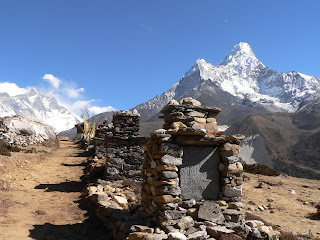Nepal is a landlocked country located in between China in
the north and India in the south, east and west. Nepal has an open border with
India to the south, east and west.
Due to the altitudinal variations country can be divided
into three geographical regions: Himalayan region, mid hill region and Terai
region. The country altitudinal ranges from highest point Mount Everest (8848 m) while the lowest point is located in
Terai region level at Kanchan Kalan (230 feet, 70m). With presence of this incredible
altitude variations the Himalayas above 3000m comprises mountains, alpine pastures and temperate forests limited by
tree-line(4,000 m) and snow line(5,500 m). Most of the highest peak out of 14
eight thousanders, eight of them are located in Nepal. Mt Everest(8848 m), Kanchenjunga(8,586m), Lhotse(8,516 m),
Makalu (8,463 m), Cho-Oyu (8,201 m), Dhaulagiri (8,167 m), Manaslu(8,163 m) and
Annapurna(8,091 m).The word Nepal is derived from original inhabitants, the Newar
'Ne' is derived from livestock and 'Pala' Sanskrit for guardian. Nepal's is god
gifted country which is rich in natural resource. Three major tributary systems are fed by mighty Himalayan snows and
glaciers, the koshi (east), Kali Gandaki (Central, This river runs through
World's deepest gorge), and Karnali(west). Most of the people are migrated to Foreign countries
in search of job which pay high amount. Due to this obstacle country economic
conditions is led by Overseas remittances.
Brief History about Nepal
Most of the part of Nepal was a pristine land. Before 4th
to 9th centuries Kathmandu was ruled by Licchavi Dynasty. The period
from 9th to 12th centuries it was a rise Vajrayana
Buddhism. During those regime several notable expansion were held. Malla
Dynasty ruled Kathmandu Valley approximately 600 years from 12th to
18th century. Before unification in late 18th century
Nepal was controlled by minor principalities. The rivalry and lack of unity was
major obstacles for Malla’s Kings. Due to which Prithvi Narayan Shah overthrown
regime of Malla King’s. Prithvi Narayan Shah was the Father of Nation for
politically unifying the country. Further more Shah Dynasty ruled over Nepal
till 2006. Several movement was made to dismantling the 239 year old monarchy
at the end of civil war.
Nepal at the Glance:
Area : 147,182 sq.km
Geography : Situated between China in the North and India in
the South
Population : 27 million
Language : Nepali
Religion : 80% Hindu, 10% Buddhism,
4% Kirat, 4% Islam, 1% Isai
Ethnic group : 125 group, 123
languages spoken
Climate :
Four major seasons
-Winter: December – February
-Spring: March – May
-Summer : June – August
-Autumn : September – November
Top Trekking Destination
Ghorepani Poonhill Trek is regarded as a panoramic viewpoint trek to watch sunrise over stunning
mountain vistas. This trek provides a tempting destination.Normally this trek
is moderate because it doesn’t take you right in among the mountains. The
Highlights of this trek is to hike early up to Poon Hill to witness one of the
spectacular sunrise views. Normally the trails are wide and well maintained and
the lodges are large in number and comfortable. During the trek we can see the
magnificent view of giants Himalayas Annapurna, Machhapuchhre, Dhaulagiri. Ghorepani Trek is a fascinating trek of Nepal. Indulge with beauty of Nature, Biodiversity and unique climate. Maximum elevation of this trek is 3210 m. Regardless hospitality of these entire region is well. They greet trekkers share their knowledge with them. Provide lodging, Fooding to them. During Trek trekkers can see mesmerizing view of gushing river,Rhododendron and glimpse of crystal clear mountain. Trial is encircled with Nayapul starting and ending point of trek. Often trekkers can plan their trek normally 4 - 5 days depending upon willingness. Trekkers can finish their trek on Ghandruk also and catch a private jeep or local bus. Ghandruk is popular for its unique hospitality, norms and traditions. Trekker can visit amazing museum, wear gurung dress. Also trekkers can witness sunrise view over crystal clear mountain Annapurna South, Hiunchuli and Machhapuchhre. Trail of these region are amazing and it offers thrilling adventure. Sometimes trekkers can witness the unity among people who work together for construction of trail, creates a sanitation program, preservation and implementation of culture. In my view people of this region are super Heros at list they are practicing same culture from their fore fathers.
If you are planning to trek this region. I will like to recommend you to plan trip for 4/5 days. Trekkers need to carry essential equipment like (Trekking boots, Sandals, Medicine, Flees Trouser,Water purifier) Tea houses and lodges in these region provides modern amenities. You don't have to worry about it. But be sure to have a company of guides they will manage everything. I will like to urge you Ghorepani Poonhill trek is awesome trekking destination.
If you are planning to trek this region. I will like to recommend you to plan trip for 4/5 days. Trekkers need to carry essential equipment like (Trekking boots, Sandals, Medicine, Flees Trouser,Water purifier) Tea houses and lodges in these region provides modern amenities. You don't have to worry about it. But be sure to have a company of guides they will manage everything. I will like to urge you Ghorepani Poonhill trek is awesome trekking destination.



No comments:
Post a Comment